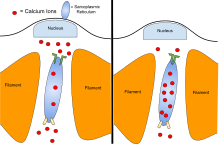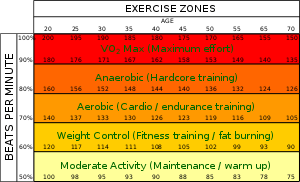Anaerobic exercise
Anaerobic exercise is a type of exercise where the body demand of oxygen surpasses the amount ventilated, and when this happens the body will utilize glucose as a source of energy (ATP). Indeed the amount of ATP produced are much less than aerobic training, that's why you can sustain anaerobic training for only a short period of time as lactic acid will build up much quicker, which will eventually lead to muscle fatigue or the anaerobic threshold. Many benefits has been implicated for this type of exercise, it stimulates the cardiovascular system, developing endurance, and reducing body fat. Aerobics offers numerous benefits like increased energy, lower blood pressure and cholesterol levels, greater suppleness, stronger bones, better posture, and decreased stress levels. To be effective, many professionals recommend that aerobic training include a minimum of three sessions per week, lasting about one hour each. For best results, the exerciser’s heart rate must be raised to a training level for at least 20 minutes.[1]
Many credit the conception of aerobics to United States physician, Kenneth H. Cooper. Cooper popularized the idea in his books Aerobics (1968) and The Aerobics Way (1977). He incorporated a system that uses point charts to rate the aerobic value of various exercises for different age-groups. As individuals progressively upgrade the quantity and quality of their exercise, they can gauge the improvement in their physical condition through the point system. Today aerobics is commonly referred to as group fitness.[2]
Anaerobic exercise may be used by personal trainers to help their clients build endurance, as well as building muscle strength and power. Anaerobic exercises coupled with aerobic exercises provide health benefits for those diagnosed with diabetes.[3][4]
Metabolism
Anaerobic metabolism is a natural part of metabolic energy expenditure.[5] Fast twitch muscles (as compared to slow twitch muscles) operate using anaerobic metabolic systems, such that any use of fast twitch muscle fibers leads to an increased anaerobic energy expenditure. Intense exercise lasting upwards of about four minutes (e.g. a mile race) may still have a considerable anaerobic energy expenditure component. High-intensity interval training, although based on aerobic exercises like running, cycling and rowing, effectively becomes anaerobic when performed at an excess of 90% of the maximum heart rate. Anaerobic energy expenditure is difficult to accurately quantify, although several reasonable methods that estimate the anaerobic component of an exercise are available.[6][7][8]
In contrast, aerobic exercise includes lower intensity activities performed for longer periods of time. Activities such as walking, long slow runs, rowing, and cycling require a great deal of oxygen to generate the energy needed for prolonged exercise (i.e., aerobic energy expenditure). In sports that require repeated short bursts of exercise, the anaerobic system enables muscles to recover for the next burst of energy or exercise. Therefore, training strategies for many sports demand that both energy-producing systems be developed.

The two different anaerobic energy systems are:
- The "Alactic Anaerobic System" comprises of high energy phosphates, adenosine triphosphate and creatine phosphate.[9]
- The "Lactic Anaerobic System" features anaerobic glycolysis.[9]
High energy phosphates are stored in limited quantities within muscle cells. Anaerobic glycolysis exclusively uses glucose (and glycogen) as a fuel in the absence of oxygen, or more specifically when ATP is needed at rates that exceed those provided by aerobic metabolism. The consequence of such rapid glucose breakdown is the formation of lactic acid (or more appropriately, its conjugate base lactate at biological pH levels). Physical activities that last up to about thirty seconds rely primarily on the former, ATP-CP phosphagen system. Beyond this time both aerobic and anaerobic glycolysis-based metabolic systems begin to predominate.
The by-product of anaerobic glycolysis—lactate—has traditionally been thought to be detrimental to muscle function.[10] However, this appears likely only when lactate levels are very high. Elevated lactate levels are only one of many changes that occur within and around muscle cells during intense exercise that can lead to fatigue. Fatigue, that is muscle failure, is a complex subject. Elevated muscle and blood lactate concentrations are a natural consequence of any physical exertion. The effectiveness of anaerobic activity can be improved through training.[11]
Anaerobic exercise increases basal metabolic rate (BMR)
Examples
Anaerobic exercise is an intense workout while aerobic exercise is a long endurance workout. Anaerobic means with "no oxygen";[12] which forces the body to use glucose in order to perform the movement. Anaerobic workouts have many benefits and can be more reasonable to do on a daily basis due to the time required. Anaerobic workouts can be performed with body weight at home.[13]
See also
- Aerobic exercise
- Bioenergetic systems
- Margaria-Kalamen power test
References
- The Editors of Encyclopaedia Britannica. “Aerobics.” Encyclopædia Britannica, Encyclopædia Britannica, Inc., 26 Aug. 2014, www.britannica.com/topic/aerobics.
- The Editors of Encyclopaedia Britannica. “Aerobics.” Encyclopædia Britannica, Encyclopædia Britannica, Inc., 26 Aug. 2014, www.britannica.com/topic/aerobics.
- "Aerobic training programs and glycemic control in diabetic children in relation to exercise frequency" (PDF). The Journal of Sports Medicine and Physical Fitness. 51: 393–400 – via Google Scholar.
- "Influence of combined aerobic and resistance training on metabolic control, cardiovascular fitness and quality of life in adolescents with type 1 diabetes: a randomized controlled trial". Sage Journals - Clinical Rehabilitation. 25: 349–359. 2011 – via PubMed.
- Scott, Christopher B (June 2005). "Contribution of anaerobic energy expenditure to whole body thermogenesis". Nutrition & Metabolism. 14. 2 (1): 14. doi:10.1186/1743-7075-2-14. PMC 1182393. PMID 15958171.
- Medbo, JI; Mohn, AC; Tabata, I; Bahr, R; Vaage, O; Sejersted, OM (January 1988). "Anaerobic capacity determined by maximal accumulated O2 deficit". Journal of Applied Physiology. 64 (1): 50–60. doi:10.1152/jappl.1988.64.1.50. PMID 3356666.
- Di Prampero, PE; G. Ferretti (Dec 1, 1999). "The energetics of anaerobic muscle metabolism" (PDF). Respiration Physiology. 118 (2–3): 103–115. CiteSeerX 10.1.1.610.7457. doi:10.1016/s0034-5687(99)00083-3. PMID 10647856. Archived from the original (PDF) on 2011-07-27.
- Scott, Christopher B (2008). A Primer for the Exercise and Nutrition Sciences: Thermodynamics, Bioenergetics, Metabolism. Humana Press. p. 166. ISBN 978-1-60327-382-4.
- Robert Donatelli, Sports-specific Rehabilitation, p. 40, Elsevier, 2007 ISBN 0443066426.
- Westerblad, Håkan (1 February 2002). "Muscle Fatigue: Lactic Acid or Inorganic Phosphate the Major Cause?". Physiology. 17 (1): 17–21. doi:10.1152/physiologyonline.2002.17.1.17. PMID 11821531.
- McMahon, Thomas A (1984). Muscles, Reflexes, and Locomotion. Princeton University Press. pp. 37–51. ISBN 978-0-691-02376-2.
- https://www.dictionary.com/browse/anaerobic?s=t
- "Want to Really Feel the Burn? Try Anaerobic Exercise!". Healthline. Retrieved 2020-02-28.
